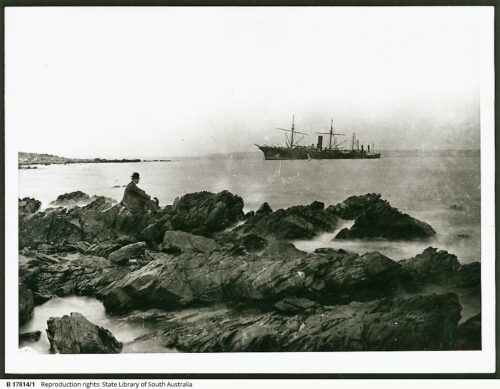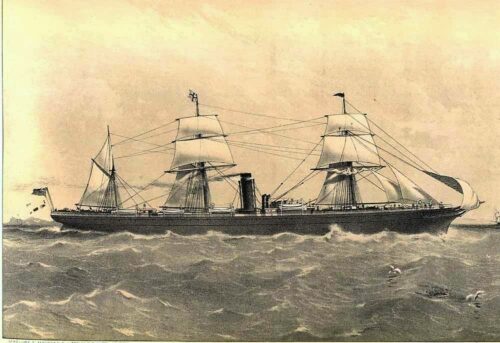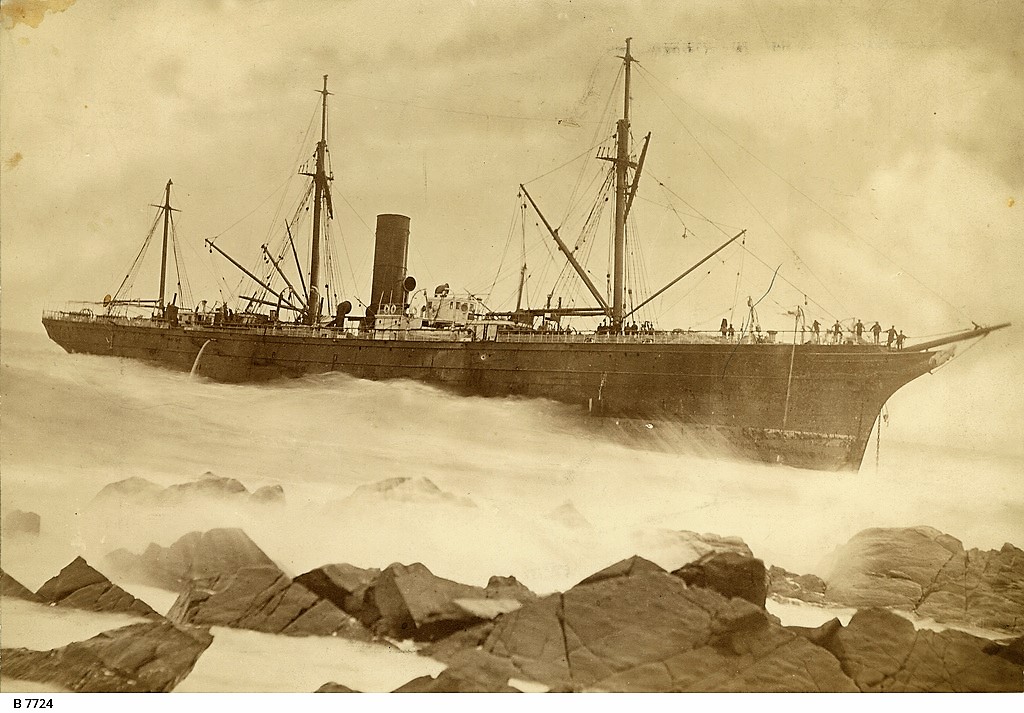The Sunday Mail of 29th June 1968 reported the grounding of the iron screw steamer Sorata at Cape Jervis in 1880. The article was written by GD (Doug) Seton, Assistant Information Officer for the SA Museum and Vice-President (at the time) for the Underwater Explorers Club of SA.

Doug had previously led an expedition to the Sorata’s grounding site.
Details regarding the wreck of the Sorata were published on pages 7 & 8 in the Sydney Morning Herald on 9th September 1880: –
“The Orient steamer Sorata, 4014 tons, from London, having called at Adelaide, and landed mails, passengers, and cargo for that port, resumed her voyage on the evening of September 3, and went ashore a mile from Cape Jervis Lighthouse, South Australian coast, at half-past 8 o’clock the same night.”
The Sydney Morning Herald’s “special correspondent at Adelaide” then gave the following details of the wreck: –
“September 5 -We reached the stranded steamer about 2pm on Saturday, the 4th. There was no question that she was close in, for hardly her own length intervened between her figurehead and a rocky coast. Her head was about south-east at first sight, and it was a truly pitiable sight as nearer approach showed the true position of affairs. At this point, which is at most a mile from the lighthouse, the coastline is not precipitous, but from a high elevation descends gently to the water line, where waves dash amongst sharp peaks rocks with occasional patches of sand and gravel. The liner was now ashore on this point, and her prospects were not of the brightest character. According to the accounts given by the best informed people on board, she had left the Roads, and made her way down the gulf in magnificent style. There was no moon, but the stars were bright, and when at 9 o’clock the course was shifted the passengers were all about the docks. It is said that some of the passengers observed that the land appeared to be close, when shortly afterwards full speed was suddenly checked by a violent concussion and sudden stoppage. The sensation caused by the shock is described as being similar to grounding on a coral reef, when the lighter parts give way and the bed rock brings up a vessel with a sudden jerk. There was no appearance of consternation amongst the passengers, and the master having made a brief speech from the bridge quite reassured everyone that no immediate danger was to be anticipated. Shortly after the steamer Woonoona turned up, and offered to assist all in her power; so, as it was almost low water on stranding, it was resolved to accept the Woonoona‘s services for the coming tide. Meanwhile, the ship’s boats were launched, and fire was lighted in the steam cutter, and preparations were made to land the passengers. The first boat down made an attempt to reach the shore in a straight line, but the surf amongst the rocks was too much for her. Fortunately she fell in with the lighthouse boat, and was then directed to the boat harbour. The people were nearly all taken out of the ship, some to the lighthouse, while some sought quarters with the residents, but next morning all were glad to return on board the Sorata under the idea that the next tide would float her. Captain Ferguson, president of the Marine Board, who was on the Lady Diana, lost no time in starting from Victor Harbour for the Sorata, but no active steps were taken to lighten the ship until the arrival of the Adelaide. On this vessel steaming alongside she made fast her hawser, and joined her power with that of the Yatala, the tow-lines being outstretched to their greatest tension, and the Sorata‘s engines going full speed astern, but as the tide had made its mark, the effort proved futile, and the Sorata leaned heavily over to starboard and then uprighted, but never made much movement astern. The anchors were let go forward and cables run out to lighten up the vessel, but she seemed to be hung in the midship section, for as soon as the down tide had run the first quarter-ebb she swung instantly around till her head was at right angles to the coastline. The impression gained ground that she was leaking, and the passengers became urgent in their entreaties to be allowed to leave. Towards sundown the Ladv Diana was hauled alongside, and took on board the Duke of Manchester and some other saloon passengers, with instructions to steam towards the north-west bluff and intercept the Victorian. The departure of the Lady Diana so worked on the remaining passengers that the Adelaide was taken alongside the after sally port, and the passengers at once made a rush, and in a very short space the tug was completely full. The Yatala steamed a short distance away and came to anchor, a good lookout being kept in the meantime for the down-coming Melbourne steamer, the Victorian. The scene was a most impressive one, for close to the rocky line of coast were more vessels than were ever at one time in the locality before. Some foolish persons on shore set fire to some undergrowth, which flared up in lines of fitful flames, sending up dense clouds of smoke. As darkness approached the surroundings were extremely interesting, as the long hull of the stranded ship, illuminated from end to end, formed the centre of the picture It was pleasant to learn, seeing how much depended on their united efforts, that throughout the first night the crew worked well and uncomplainingly. The Victorian arrived on the scene at midnight with a lighter. At this juncture there came a change in the weather, and dark ominous clouds showed very badly for future operations. The leakage in the Sorata had been most unwisely kept quiet; but very soon it became apparent that it had so far increased as to be of serious import, increasing from three feet to four feet nine inches in one compartment. This fact, with an evident change in the weather, was of immense interest as the night wore on. When the Victorian reached the neighbourhood, she was met by the Yatala, just off the lighthouse, where she let go the lighter Legal Tender, and then followed the tug towards the vessel till she had notice to anchor in a proper berth for receiving passengers. The steam cutter of the stranded ship was at hand ready to receive Mr. Yuille, the manager, who had come down by the Victorian. The tug steamed alongside of the Sorata, and, making fast at the port gangway, received on board a perfect rush of passengers. It was a most pitiable spectacle in the dark to observe brave men and fair women hurriedly transferred from the ill-fated ship. It became known that the Sorata‘s fore compartment was full of water, and the shocks on her bottom plating had been so severe that there was little hope of the vessel getting off. During the whole time the screw had never ceased its sternward motion, but although it was said to be merely a preventive to the vessel’s rolling, older hands knew well enough it was part of the process of pumping out water, and likely to be an exhaustive one. Mr Yuille instructed the masters of the tugs as to their course of procedure, and meanwhile the third-class passengers were put on board the Adelaide, which had anchored but a short distance away. The balance now were taken on board the Yatala, thus completely clearing out the vessel. Such a pitiable wreck of everything was much to be deplored. As the vast ship laid on the rocks with a slight port list she was lighted up as usual, but the corridors were vacant, save that here and there some person rushed to save a trunk or some forgotten hat-box. The sullen, fruitless beat of the engines engaged in stirring up the water aft, but perhaps profitably engaged in getting out the water from below, was the only sound beyond the working of the hands as they discharged cargo into the lighters alongside. The steam cutter belonging to the vessel did good service as she sped to and fro with messages. Later on a new feature of interest arose. As the ebb tide made down it seemed for a time to have a slight effect, but after a time it caught the vessel on the port quarter and slewed her slowly round. This was the turning point which, in effect, settled the question. A little later on there were some convulsions forward, and it was very evident that she had opened out to such an extent as to allow free passage of the tide. There was no longer room for any delay, but as soon as the Yatala could be brought round into position, the passengers left the vessel, most of them being apparently callous as to where they were bound, and no definite arrangement was made, even when the tug reached the Victorian. Some transhipped, while a great many remained behind to wait the issue of events. The Victorian had room for a large number, but very few availed themselves of the opportunity, compared with the number on board. Morning broke cloudy and frowning, the weather had completely changed, and a strong breeze had brought down a very short jerky sea, which, on the ebb tide, created quite a commotion as it swept past the big ship. All hope of getting off had now passed away, the hold being full of water, and the probability being that her bottom was pierced in every direction. She lay completely end on to the shore, with her bowsprit almost overhanging high water mark. Under her stern port there was plenty of water, but by force of going on shore and subsequently slewing round, the bows had been very much raised. The scene of activity and bustle had completely changed, and there was not a whiff of smoke out of the funnel, which showed the mighty engines had relapsed into silence. The steam cutter of the Sorata had broken down and was hanging astern, and the whole aspect was one of utter desolation. Seeing there was nothing further to be accomplished in the way of salvage, and no probability of the vessel coming off, the Lady Diana left and headed away for the port. The fore-hold, stoke-hold and engine-room are full of water, and the fires are out. The position of the wreck is the same as yesterday. Communication is had with the shore by the Sorata‘s steam launch when required, but she has not been on shore since. 5 o’clock.
Cape Jervis, September 5 -The Sorata remains in much the same position, with a list to starboard, and every hour shows less possibility of getting her off, as the water is increasing in the hold, and the hold is awash. The hole in the starboard side must be very large, as the seas flow right in, and sand has accumulated considerably. The vessel is rolling slightly in consequence of the rising tide, and there is a great body of water awash in the hold. The water almost covers the boilers, and is from fifteen to twenty feet deep. Three of the largest amidships compartments are half full; there are seven compartments in all, and the damaged ones run about two-thirds of the steamer’s length. The greater part of the Melbourne exhibits are in the undamaged compartments, but it has been ascertained that two large cases are under water. The consignees of these cases are not yet known. The lighter Legal Tender came alongside about 2 p m., with 28 extra lumpers, who are now engaged discharging cargo, with other lumpers who had arrived previously and the crew. The stevedore’ s arrangements were under the charge of Captain Begg, and Mr Yuill, agent for the company, visited the vessel. Captain Begg, if he had sufficient lighters on the spot estimates that he could clear the cargo in two days but the work is proceeding slowly under present conditions, and will take more than a week. The lighters at first declined to come alongside, on the ground that the sea was too heavy, although the yacht Britannia, from Kangaroo Island, and a small steamer boarded her in the morning. A slight misunderstanding, which, however, was soon got over, occurred amongst the ships’ crew, who wanted a definite understanding in respect to the payment they would receive for cargo lightening. They were led on by one of their number, an old sea lawyer, who laid down the rule that when a ship struck the crews’ wages immediately stopped. Captain Begg quietly spoke to the men, assuring them that their wages would be paid, and pointing out the discredit which would attach to them if they did not assist the distressed vessel and on his assurance the men went quietly and earnestly to work. The decks are crowded with cases and remnants of passengers’ luggage. Most of the latter, however, has been transhipped to lighters and sent on either to Adelaide or Melbourne. Down below in the deluged compartments the spectacle is melancholy in the extreme and especially in the engine-room, which is filling with water and the sand is surging amongst the magnificent machinery. The saloon presents a deserted, but not a desolate appearance. The bunks are emptied, and minor nicnacs are strewed about, showing evidences of a hasty departure. On shore the prospect is not cheering; the coastline is bleak, and somewhat rugged, and a heavy surf continually breaks in on a jagged and uneven bed of rocks which fringe the coast, hinting at an ugly natural bottom, on which the vessel stranded. Communication with the shore is somewhat difficult, in consequence of the surf on the coast. On the hills can be seen several vehicles and horses, numbers of persons having apparently come to see the stranded ship. The nautical authorities on board express no hope whatever of the vessel getting off, and predict that if a heavy sea round the coast comes in she will probably break up. The sailors have been engaged sending down the top hamper to relieve the strain on the vessel, and reduce her liability to labouring. It was intended to obtain American pumps from Port Adelaide, but Captain Begg now says that these would be useless, as the water is running in faster than it could be pumped out. While writing, the labouring of the vessel feels more jerky, as if she were bumping roughly on the rocks instead of her former easy roll. This is shortly after 4 pm, and forward the deck timbers show symptoms of opening. Divcr Othern, who is on board with his apparatus, thinks no good can be done going down this afternoon, and present efforts are directed to lightering and, while the present weather lasts, there is no immediate danger of the vesse1 going to pieces but the sea bottom is composed of very rough hard granite rocks, and every hour increases the damage to the hull. The captain attributes the disaster to the setting in of a strong tidal current canting the vessel’s stern and causing her to steer badly; and also to a deflection in the compasses, which, he says, have gone wrong. The Duke of Manchester, who went onto Melbourne with Colonel Sandford in the Victorian, was on the bridge with the captain at the time the steamer struck, and his Grace says there was a haze so thick that he could not see the water’s edge. The optical effect of the haze was that the coastline seemed very distant. Nothing was more unexpected than the shock of striking. He and the captain both say the shock of grounding was very slight, and little confusion prevailed on board, the ladies especially behaving themselves grandly. Some shrieking came from the steerage passengers, but it was soon quieted, and the boats being got out and a steam boiler coming alongside, confidence was soon restored. A passenger, who was under the bridge at the time of grounding, says the shocks were frequent and somewhat severe. He denies that any haze existed, and says he could see the coastline distinctly, and was just about to sing out ‘For God’s sake keep her out,’ when she struck. He went back to Adelaide by the steam tug Yatala, but has not given his name. The captain is of opinion that the first shock of grounding did not break the hull, but that the damage was inflicted when the tugs were trying to get her afloat next morning All the passengers have been transhipped either for Melbourne or for Adelaide, only the crew and lumpers remaining. A great deal of confusion prevailed during the transferring of passengers, the arrangements not being satisfactory, and many of the passengers were without food for many hours. Every available part of the tugs Yatala and Adelaide was occupied, and the forms of passengers – men, women, and children – were lying about, in some cases huddled up indiscriminately in neck-breaking positions. Captain Begg expects additional lighterage assistance tonight or tomorrow There is no present means of communication with the shore except by signals. The steamer Ridge Park is coming down with a centrifugal pump. 230 feet of the main hold of the Sorata is full of water, but the fore and half holds are now clear, the bumping being much lighter. The diver intends going down the main hold tomorrow morning. He goes down just abaft the fore coal-bunkers. The reports as to the nature of the of the weather on the night of the disaster are very contradictory. Some of the men forward declare the night was very clear and that they could see the coast plainly almost as well as at daybreak, while others of the ship’s crew say there was a haze. Much sympathy is felt for the captain, who seems terribly cut up about the disaster. He was very popular with first and second class cabin passengers, but a very strict disciplinarian with the crew. In reference to the statement of a passenger, who said he was under the bridge, I don’t think any person about the bridge could properly see the shore, as the deckhouse and other fittings on either side would obstruct the view. The object of the diver in going down at present is simply to report. The general opinion is that the ship cannot be floated, and will go down if she is got off the rock, but all depends on the diver’s report. If that is favourable he may be able temporarily to repair the damage before getting her afloat. All the fore mast gear has been taken down, and the sailors are now taking down the main topmast gear. The Ridge Park was alongside at 8 o’clock.
September 6. -The Sorata is full of water, and there are no hopes of getting her off now. She has not shifted since the steam-tugs left her on Saturday. The Ridge Park is now alongside, getting out the cargo. The greater part of the cargo will be destroyed. The wind is light and variable, the weather overcast, and the sea smooth. 2pm -The water is slowly increasing, and the ship seems to be settling down, in spite of cargo lifting. The tug Adelaide and the Ridge Park are both taking in cargo. Two centrifugal pumps are on board, and Captain Begg has telegraphed for additional pumps from Melbourne, per Chimborazo, hoping that, with plenty of pumping gear, he might be able to pump her out; but the general opinion as to saving the ship is anything but sanguine. The reply of the chief officers to Captain Begg’s statement that the pumps now on board would empty the hold in four hours, was “Then you will have to pump the ocean dry.” The diver has been down the fore-hold, and had to cut away part of the bulkhead in the orlop deck to pass through the coal bunker.
He has not much to report yet, as he has not been forward far enough to where the greatest injury is supposed to be. It is too dark down below for him to see the extent of the damage. He is now going down outside the vessel, and will probably have something definite to report when he comes to the surface. It is intended to fix a pump above the engine-room, where the water now nearly covers the boilers. The reports as to the accident are still contradictory. Most of the crew, in speaking of the disaster, say that the night was quite c1ear and starlit, and the land plainly visible, while others say there was a haze. Some of the people on the tug, when trying to haul her off on Saturday, say she was actually off once, as the anchor chains were dragging, and that on account of the vessel filling her engines were put full speed ahead, to run her on again; the steamer people, on the contrary think she was not off at all but simply slewed round by stern, and got harder aground than ever. In reference to the sailor who took French leave, I am informed that he returned to the ship next morning of his own accord. The officers speak well of the men generally, but there were one or two cases of skulking. The chief officer found one man skulking in the forecastle after the ship struck, and he knocked him down, the presence of the Duke of Manchester not deterring him from using the strongest nautical epithets. There is now the cross engine at work, which facilitates lightering. Captain Begg has sent for two more cross-engines from the Port. The weather is gloomy, but there is little wind and no sea. 4pm.: The diver has been down over the side, examined outside the hull from about amidships forward, on the port side. He reported that very little damage was done to the port bridge, only one or two indents being found. He found when examining inside the hull symptoms of serious denting, but outside the appearance did not correspond, and the inference is that the principal damage is at the very bottom of the ship, which is of course not accessible. She is lying on very rough boulders. The boulders underneath are all squashed flat, which speaks well for her strength. The water has gone up the compartments, which is due to the injury done to the dividing bulkheads, as all the timbers are very much strained. The lighter Ridge Park and tug Adelaide are proceeding with the utmost despatch, and all available furniture, cabin and otherwise, is being got on deck. The view of the situation after the diver’s report appears more hopeful, but with so much water in the hold he can give no definite opinion. The diver is to examine the starboard side next, but even if the report there is favourable, there is the injury right underneath the vessel to be remembered. The steamer’s shape is such that she is nearly flat-ribbed underneath and amidships. The cargo will first be cleared, and then the pumps rigged. This work will take a day or two, probably, and the weather must be reckoned as an item in the possibilities. It has been raining softly all the afternoon, with a misty horizon, but shows signs of clearing. The wind is light and the sea calm. 5 p. m. – The captain is confident that with sufficient pumping apparatus he will get her safely off. The man at the wheel when the vessel struck says the night was quite clear and starlight, and no haze existed, as he could plainly see Cape Willoughby light. The sea is now getting up and the night looks threatening. Probably heavy weather is coming, and from a bad quarter. The Duke of Manchester proceeded by the Victorian to Melbourne. A telegram from Cape Jervis, at 5 p m on Monday evening, states that the diver, on examining the bottom on the port side, reported seeing one very small hole on the starboard side. They are getting cargo out of the aft-hold fast into the Ridge Park. Bulkheads all more or less damaged. Wind S., fresh and increasing; sea rising.
Adelaide, Tuesday. – The weather is still overcast, with light showers, but it appears to be clearing up. The wind is fresh, but moderating a little. Among the steerage passengers on board the Yalata from the stranded steamer, and sent on to Port Adelaide, were an aged woman, a foreigner unacquainted with English, and a little boy four years of age. At daylight the woman was found exhausted with the child on her knees, but he could not leave her. In the darkness and confusion the poor woman’s condition was not noticed. When discovered, however, every attention was paid to her, but she died shortly afterwards. It appears the boy is her grandchild, and she was bringing him to his parents in Melbourne. Cape Jervis, September 7. -The Mary Miller brought additional lumpers and engines, and some hand crab-winches. Four engines are now available. The cargo is being got out of the fore-hold into the Mary Miller. That hold is perfectly dry, and so far the cargo is found to be in good condition. In the other holds the water is perfectly still. Outside, the diver has examined the whole length of the starboard, and has been down again on the port side. His report is more favourable, and the injury to the steamer is not so great as imagined. The diver reports being unable to find the hole in the Sorata‘s hull. The injury must be right underneath, but the ship’s plates, which would show if the injury is great or not, could not be seen. A great portion of the exhibits for the Melbourne Exhibition are all right, but a number of cases are underwater. The Thales has been chartered to take 250 tons of the Sorata‘s cargo to Melbourne and Sydney. Yesterday the Ridge Park took a cargo of ship’s plate and linen, and left the Sorata about midnight. The drizzle thickened tonight into heavy rain, and work is stopped in consequence of the pumps not being rigged. They are, however, nearly ready. It is thought that the pumps from Melbourne by the Chimborazo may be direct acting centrifugal; if so they would be almost useless, on account of the impracticability of rigging both pumps and engines on the main deck. The general feeling is hopeful and if the present weather continues, the vessel will probably be floated. On Monday night an attempt was made to break open the storeroom, two bars were wrenched away, and an attempt was made to draw the back bolts. The attempt was frustrated, in consequence of the inside padlocks. Last night one of the steward’s mates kept watch in the storeroom with a loaded revolver. It is supposed that the object of the men was to get at the grog stores. The captain is sending for a second diver. In reference to the landing on the night of the disaster, Mr Green, third officer, states he was in charge of the boat landing, and but for the lighthouse-keeper he would have gone right on the reef, which runs out a great distance right abreast of the lighthouse. He states that the last Admiralty chart does not show this reef, which is certainly most curious and unaccountable. The reef is covered at high water, and could not be seen on a dark night.”
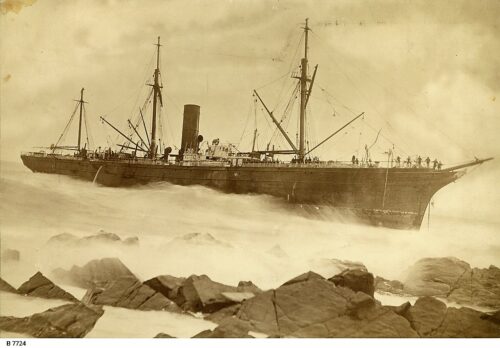
The Sorata was eventually recovered. She had been grounded since late on 3rd September. It finally got off on 13th November (1880) and it was then repaired in Melbourne. Although it was registered to the Pacific Steam Navigation Co., it was chartered to the Orient Steam Navigator Co. Ltd. at the time of its stranding. It reverted back to the Pacific Steam Navigation Co.’s service in 1886. It was broken up at Tranmere, Cheshire (a suburb of Birkenhead, England) in 1895.
The (successful) recovery attempts on the Sorata led to the sinking of a barge – Hopper Barge No.3 – alongside the Sorata on 21st October 1880. “Shipwrecks of South Australia – Book Two – 1876-1899” by Ronald Parsons gives accounts of the stranding of the Sorata and the sinking of the barge. So too, does Doug Seton in his article in the Sunday Mail of 29th June 1968.
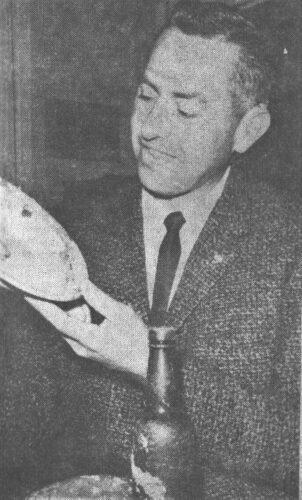
Doug Seton in 1968
“South Australian Shipwrecks – A Data Base 1802-1989” by Peter Christopher includes details about the Sorata, which was not wrecked, but not details about the Hopper Barge, which was wrecked. “Australian Shipwrecks Volume 3” by Jack Loney also includes details about the Sorata.
I found these details about the barge online: –
Wreck Name – Hopper Barge No. 3
Hull – Iron
Length – 34.8
Built – 14/01/1880 at Glanville
Loss Date – 21/10/1880
Location – Backstairs Passage, 1.3 miles south of Cape Jervis, South Australia
Cause – Sunk due to heavy weather. On 4 September 1880, the Orient Lines steamer SS Sorata stranded on a ledge of rocks about a mile south of Cape Jervis. The vessel was not badly damaged and in order to refloat the vessel, it was determined that a barge was required to carry silt ….
Latitude -35.6245
Longitude 138.094
I have long held this mud map of the wreck site: –
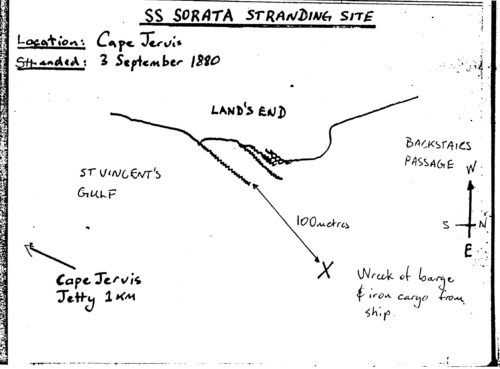

Doug Seton more recently
Doug Seton sent me this painting featuring the Sorata: –
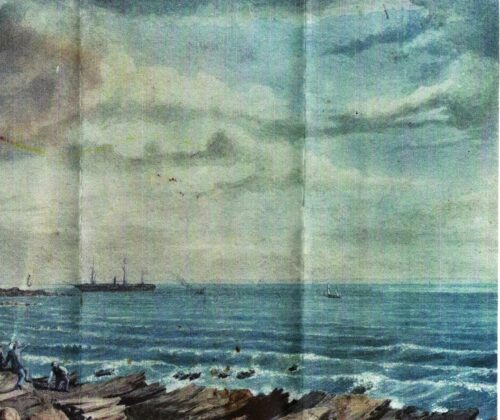
Here are some more photos of the Sorata: –
